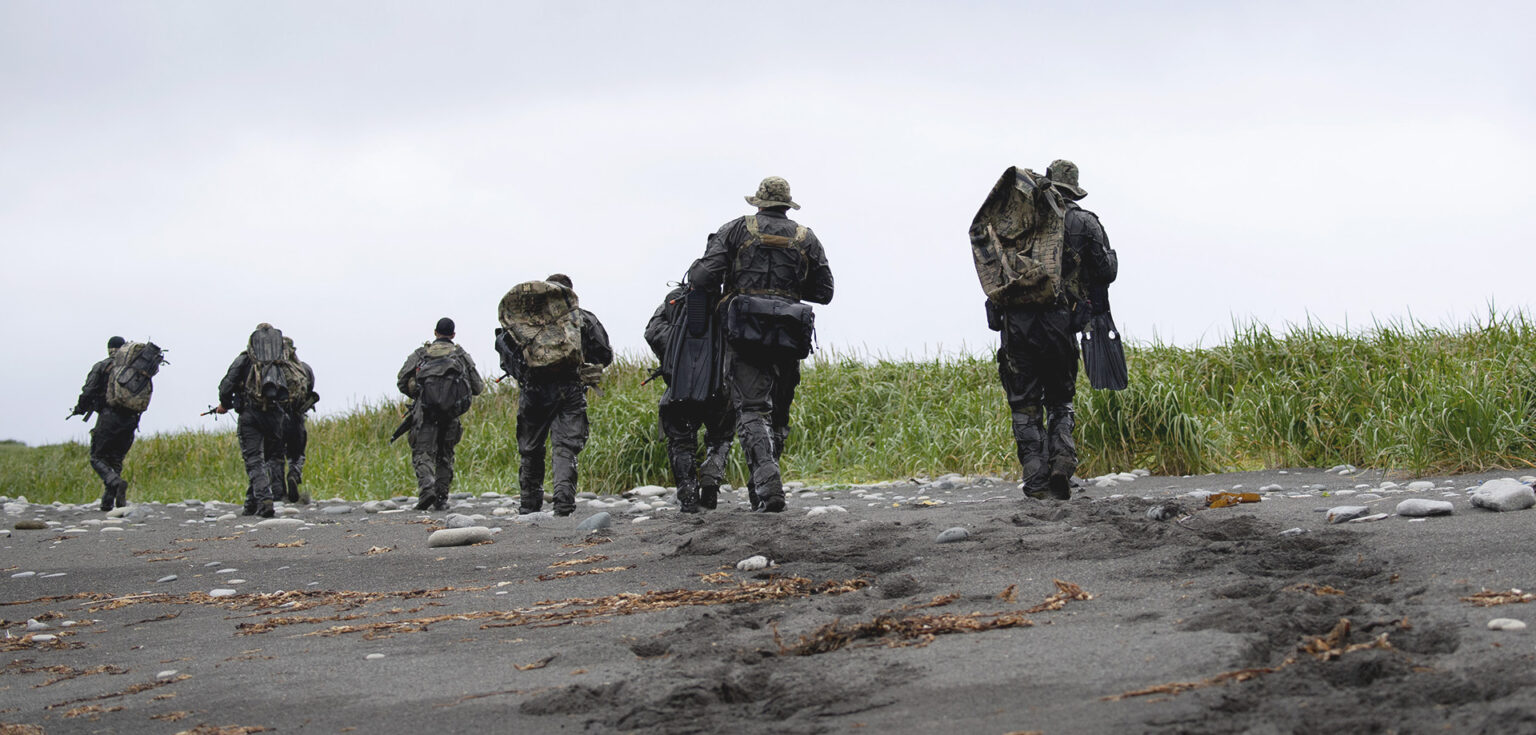U.S. Naval Special Warfare Operators (SEALs) patrol Shemya Island, Alaska, as part of Operation Polar Dagger. U.S. NAVY
THE WATCH STAFF
A recent joint military exercise in Alaska provided an opportunity for personnel from U.S. Special Forces Command North (SOCNORTH) to improve their knowledge of Arctic conditions while demonstrating operational reach and domain awareness by integrating with the USS John P. Murtha in the Bering Sea.
Operation Polar Dagger showcased the ability of special forces operators to deploy new and emerging technologies and demonstrate their ability to defend critical infrastructure in austere locations. The exercise, which occurred from August 15 to September 10, 2023, included the Shemya, Attu and St. Lawrence islands.
The operation demonstrated that special operations forces “can effectively compete in the Arctic and will continue to identify challenges and develop creative solutions to detect, deter and disrupt threats in the region and throughout the U.S. Northern Command’s [USNORTHCOM] area of responsibility,” said U.S. Army Col. Matthew Tucker, SOCNORTH commander, according to a news release from the command. “Our greatest competitor in the Arctic is the environment.”
Starting August 15, the North American Aerospace Defense Command (NORAD) and USNORTHCOM initiated Operation Noble Defender in Alaska to demonstrate the ability to advance integrated deterrence and layered defense for Canada and the U.S. Alaskan NORAD Region. USNORTHCOM provided special operations forces and capabilities to Operation Noble Defender through Operation Polar Dagger.
During Operation Polar Dagger, joint U.S. Special Operations Forces expanded their operational reach by integrating with the USS John P. Murtha in the Bering Sea. Also, special forces employed new and emerging technologies and assessed competitor activity in the Arctic.
This year’s operation challenged special forces to learn the movement of forces and capabilities, employ and assess communication systems, and sharpen the skills necessary to defend the northern approaches to the homeland.
Special operations forces deployed from the well deck of the Murtha in combatant craft assault boats into the Bering Sea and onto Shemya Island, according to the Navy Times newspaper.
On Shemya, they conducted an “over-the-beach” patrol and then left by helicopter, showcasing how special forces can team up with a conventional fleet in frigid environments, according to the Navy Times.
More than 150 joint special operations forces from across 10 states conducted over-the-beach operations, special reconnaissance, long-range movements, threat assessments of defense critical infrastructure, rapid resupply, personnel recovery and community engagement with Indigenous tribes.
“Partnerships are fundamental to (special operations forces) and to all our missions and endeavors,” said a U.S. Army Special Forces operational detachment commander assigned to 10th Special Forces Group (Airborne). “Our team had the opportunity to engage with the Alaska Native people on St. Lawrence Island and learn about their best practices on survival techniques in the subarctic terrain. We place incredible value on what we can learn from the Alaska Native people who have generational experience in this extreme environment.”
Units from the 17th Special Operation Squadron deployed an AC-130J Ghostrider aircraft — its first Arctic deployment — alongside the 160th Special Operations Aviation Regiment MH-60 Blackhawks, and 207th Aviation Troop Command, Alaska Army National Guard, UH/MH-60 Blackhawks and CH-47 Chinook helicopters. The joint special forces and total forces air components supported the 10th Special Forces Group (Airborne) Green Berets and East Coast-based U.S. Naval Special Warfare Operators (SEALs) with helicopter insertion and extraction, validating search and rescue capabilities, air-to-ground integration, aerial overwatch, fast-roping, and close air support.
The U.S. Air Force Special Operations Surgical Team from the 720th Operational Support Squadron provided a rapidly deployable trauma medical team to the operation.
“Operation Polar Dagger provided our joint and total forces the opportunity to operate together and conduct in-person communications,” said U.S. Air Force Chief Master Sgt. Clint Grizzell, SOCNORTH’s senior enlisted leader. “The ability for our forces to look each other in the eyes, in real time, provides unmatched value, especially in the austere environment of the Arctic.”

